The Significance of Resin Coated Sand Plants in Modern Foundries
In the world of metal casting, the materials used in the production process play a critical role in determining the quality of the final product. Among these materials, resin coated sand has gained significant traction due to its superior performance characteristics compared to traditional sand molds. The establishment of resin coated sand plants has become a pivotal development in modern foundry operations, providing enhanced efficiency and product quality.
Resin coated sand is formed by mixing fine silica sand with a thermosetting resin binder. This mixture is then heated, causing the resin to coat the sand grains uniformly, creating a strong and durable mold material. This process imparts several advantages to the resulting sand, notably its ability to withstand high temperatures and its remarkable dimensional accuracy. Consequently, resin coated sand is often preferred in applications where intricate designs and high-quality finishes are required.
One of the primary benefits of utilizing resin coated sand is the improved mechanical properties it offers. The strength and rigidity of the molds produced from this type of sand allow for better handling and less deformation during the casting process. As a result, manufacturers experience fewer defects, leading to a lower rejection rate and higher production efficiency. This advantage is particularly critical in industries such as automotive, aerospace, and heavy machinery, where precision is vital, and any casting defects could lead to significant financial losses and safety concerns.
resin coated sand plant

Another significant advantage of resin coated sand is its ability to facilitate complex geometries. The fine grain size and uniform coating of the resin enable foundries to produce highly detailed and intricate mold designs. This capability means that designers can push the boundaries of casting design, allowing for unique product shapes that were previously difficult, if not impossible, to achieve with traditional sand molds. As industries continue to advance, the need for innovative designs is paramount, making resin coated sand an essential material for future development.
In terms of environmental impact, resin coated sand offers a more sustainable option compared to other molding materials. Many resin systems used in the production of coated sand are designed to minimize environmental hazards. Furthermore, the durability of resin coated sand allows for multiple uses before it needs to be replaced, reducing material waste. Innovations in recycling technologies also mean that used resin coated sand can sometimes be reclaimed and reused, further lessening the environmental footprint of foundry operations.
Setting up a resin coated sand plant involves several critical aspects, including investment in advanced technology and understanding the processing techniques essential for molding quality sand. The facility needs state-of-the-art mixing and thermal curing equipment to ensure that the resin binds effectively to the sand. Moreover, maintaining stringent quality control measures is crucial throughout the production process to ensure that the coated sand meets the required specifications and performance standards.
As the demand for high-quality cast products continues to grow, the role of resin coated sand plants in the foundry industry is set to expand. Their ability to provide superior material properties, design flexibility, and sustainability makes them an attractive solution for manufacturers aiming to stay competitive in an increasingly demanding marketplace. With ongoing innovations and advancements in both resin technology and processing techniques, resin coated sand will undoubtedly remain a cornerstone of modern metal casting for years to come.
Post time:Nov . 08, 2024 20:44
Next:foundry sand
